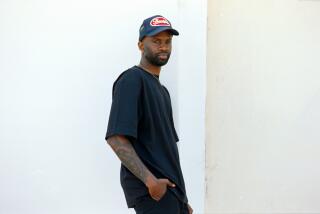Mixed Media : Reversing a ‘Negative Image’
For too long, they say, their voices have been ignored, their faces overlooked and their stories stereotyped.
The creators of several new, Los Angeles-based quarterly ethnic magazines are hoping to change all that, targeting markets they say are largely untapped.
Charles Squires, director of the New York-based Ethnic Magazine Coalition, notes that most new magazines fail because they are either underfinanced or poorly distributed. “To give voice to an ethnic group is . . . empowering,” he says. “To not have the money or the know-how is not.”
But these local entrepreneurs have accepted the long odds, launching Image, a magazine for men of color; Que Linda! an English-language beauty and fitness magazine for Latinas, and YOLK, a popular-culture periodical targeting young Asian Americans. Times staff writer Michael Quintanilla tells their stories.
*
It is time for men of color to re-emerge to a position of prominence and strength; brought about by ourselves and for ourselves. --J. Edward Giles III, publisher, writing on his mission for Image magazine
*
J. Edward Giles III sits in his “war room”--an office decorated with kente cloth and African art on the walls, including a tribal ceremonial rod for fighting off evil spirits. Giles leans forward, mentions his guest spot on a recently taped “Donahue” show about black-on-black racism, then stops cold. Before he goes on about the present, he wants to bring up the past.
The year: 1989.
The place: Prison.
Giles, 32, publisher of Image--a new magazine he created to “empower the man of color”--spent a year in Chuckawalla Valley State Prison in Blythe and two more at the California Institution for Men in Chino, an experience he calls “my pit time.”
For Giles, incarceration led to an analysis of the plight of African American men, who he says are often bashed as “inherently evil, inherently destructive, inherently negative.”
Out of this was born Image, which he says will explore controversial African American cultural issues and, he hopes, provide solutions to the problems that plague all men of color. The national publication debuted last month with a press run of 80,000 and a $2.95 cover price.
“When I was in prison it was the most amazing thing,” he says. “I met hundreds of men like me--bitter, angry, sad. I met murderers who just got started out in life on a destructive path, men who didn’t have a chance, guys who never heard the words ‘I believe in you.’
“I know from experience what that feels like. ‘I believe in you. I care for you. I love you,’ these things were a void in my life too,” adds Giles, whose parents divorced when he was 9. “My parents did try to do the best for me. It’s when they broke up that the violence and the bitterness started.”
But Giles says he persevered, surviving a Compton neighborhood known as “the Swamps,” where gang violence and drug dealing are commonplace.
After high school, he attended Howard University in Washington, D.C., where he studied philosophy. Later, he studied law at the Southern California College of Business and Law in Brea.
In 1989, he found himself on the wrong side of the law. He attacked his wife, was charged with injury to spouse and sent to prison. “I deserved to go to prison,” he says. “I didn’t necessarily deserve them throwing the book at me. But what I did was wrong.”
After serving his sentence, he worked as a legal document analyst for an oil company, and later for a law firm, handling worker’s compensation and personal injury cases as a hearing representative for attorneys.
But he never quit thinking about the magazine. In March, using mostly his own money, he formed the company, with offices near Universal Studios, that publishes Image.
He says the magazine will “take back our negative image and reverse it” as well as “sever the good from the bad, the truth from the lie.”
A high-quality, beautifully designed periodical, Image will not carry advertisements “for counter-productive products such as tobacco and alcohol.”
Not shying from taboo subjects, the premiere issue features the article “Nigger, please,” which traces the history of the “N-word” and its acceptance among some African Americans, in rap music and among white kids who want to be known as “wiggers.”
Health and fitness articles, arts and entertainment, and Man-to-Man, a first-person column addressed to a man who has affected the writer’s life positively or negatively, will appear regularly. The first Man-to-Man will feature an open letter from a man talking to the rapist who assaulted his mother.
“I’m not a publisher. I just knew that the same guys in prison I had met as demonic and evil--as the world wants to tell them that they are--didn’t have anyone stand up for them and say, ‘Wait a minute, let’s talk about some of the reasons that we got to this position.’ Maybe by doing that we can exorcise the demons.”


